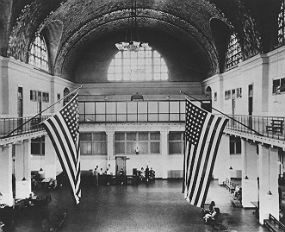Ellis Island Immigration
Nestled in New York Harbor beside the Statue of Liberty, Ellis Island stands as one of the most iconic symbols of American immigration. From 1892 to 1954, it served as the nation’s busiest immigration inspection station, welcoming millions of hopeful newcomers seeking a better life in the United States.
A Wave of Humanity
During the late 19th and early 20th centuries, the U.S. experienced a massive influx of immigrants—over 30 million people arrived between 1840 and 1920, driven by war, poverty, persecution, and the promise of opportunity. Ellis Island became the focal point of this movement, processing more than 5,000 people per day at its peak.
Immigrants came from all corners of the globe—Italy, Ireland, Germany, Russia, Poland, and beyond. For many, Ellis Island was the “Island of Hope”, a place where dreams began. But for others, it was the “Island of Tears”, where families were separated and entry was denied.
The Inspection Process
Upon arrival, immigrants underwent a rigorous inspection process that typically lasted 3 to 7 hours. They were checked for medical issues, legal eligibility, and financial stability. A chalk mark on a coat could mean further examination or even deportation. Despite the challenges, over 98% of arrivals were eventually admitted.
Legacy and Transformation
Ellis Island closed its doors as an immigration station in 1954, with the last immigrant being a Norwegian merchant seaman named Arne Peterssen. Today, the island is home to the Ellis Island National Museum of Immigration, preserving the stories of those who passed through its halls.
The legacy of Ellis Island is profound. It represents resilience, hope, and the enduring spirit of migration. Many Americans can trace their ancestry to someone who walked through its doors, making it a cornerstone of national heritage.
Why Ellis Island Still Matters
In today’s immigration debates, Ellis Island functions as an emblem of the human tales behind policy and politics. It’s a tribute to the bravery of those who left everything behind to start over—and to the country that embraced them.
Whether you’re a history buff, an immigrant descendent, or simply curious about America’s roots, Ellis Island provides a powerful window into the past—as well as a mirror to the present.
Ellis Island Immigration – FAQs
1. What was Ellis Island used for?
Ellis Island served as the primary immigration inspection station in the United States from 1892 to 1954, processing over 12 million immigrants arriving mostly from Europe.
2. Where is Ellis Island located?
It’s located in New York Harbor, near the Statue of Liberty, between New York and New Jersey.
3. Why did immigrants come through Ellis Island?
Most immigrants came seeking economic opportunity, religious freedom, or escape from war and persecution. Ellis Island was the first stop for those arriving by ship to the East Coast.
4. What happened during the inspection process?
Immigrants underwent medical and legal inspections. Doctors checked for contagious diseases, and officials reviewed documents to determine admissibility. The process could take a few hours to several days.
5. Were all immigrants allowed to enter the U.S.?
No. While about 98% were admitted, some were detained or deported due to health issues, criminal records, or lack of documentation.
6. What is the “Island of Tears”?
Ellis Island earned this nickname because some immigrants were denied entry, leading to emotional separations from family or the end of their American dream.
7. When did Ellis Island close?
It officially closed as an immigration station in 1954. The last person processed was a Norwegian seaman named Arne Peterssen.
8. Is Ellis Island open to the public today?
Yes. It’s now home to the Ellis Island National Museum of Immigration, operated by the National Park Service. Visitors can explore exhibits and search family immigration records.
9. Can I find my ancestors’ records from Ellis Island?
Absolutely. The museum offers access to passenger manifests and ship records, and online databases like the Ellis Island Foundation help trace family history.
10. Why is Ellis Island important in American history?
It symbolizes America’s immigrant heritage, representing the hopes, struggles, and contributions of millions who helped shape the nation.


Leave a Reply